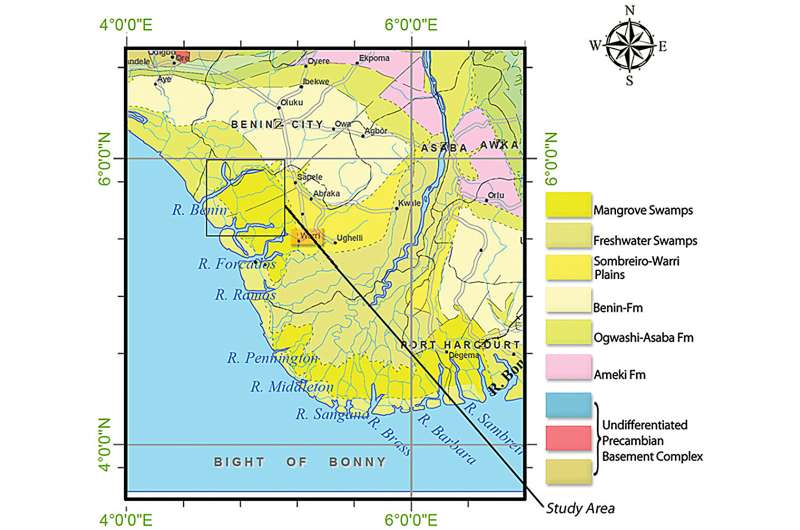This article has been reviewed according to Science X's editorial process and policies. Editors have highlighted the following attributes while ensuring the content's credibility:
fact-checked
trusted source
written by researcher(s)
proofread
Nigeria's Niger Delta biohazards: High radioactive levels detected

The Niger Delta, in southern Nigeria, is one of the most significant oil-producing regions in the world. It spans over 70,000 square kilometers and is also an area of great biodiversity, including mangroves, swamps and rainforests. However, the region has been plagued by severe environmental pollution for decades, primarily due to extensive oil exploration and production activities.
By 2010, between 9 million and 13 million barrels were estimated to have been spilled in the Niger Delta since 1958. From 1976 to 2018, a total of 17,301 spills occurred, dumping nearly three million barrels of oil into the environment.
Between February and April 2020, dead fish washed up on parts of the Niger Delta's Atlantic coastline in unusually large numbers. The Unumherin community in Delta State experienced this in March that year.
This sudden and unusual occurrence heightened concerns among the residents. The people rely heavily on these waters for their livelihoods, including fishing and other daily activities. The dead fish also pose potential health risks to the community. A thorough investigation into the likely causes was needed.
Our team of environmental physicists and marine biologists investigated the level of chemical and biological pollutants in the Unumherin community. We also investigated the radioactivity effects on the residents and conducted a biohazard assessment of the environment. The findings are published in the journal All Earth.
Our assessment found biohazards and bacteria in the dead fish tissues and the environment at levels higher than the US Environmental Protection Agency standards. This poses significant danger to the people living in the area. The likely causes include oil corporations' activities like gas flaring and oil spills. Sadly, this particular incident was not tackled despite protests by the citizens.
Unexplained fish deaths
We suspected the deaths of fish in the environment might have been the result of pollutants from an oil spill from February to April 2020. The incident suggested that there might be something harmful in the water affecting the marine life and potentially the health of local people. We wanted to determine whether it was from radiological risk or if biohazards, such as harmful bacteria or chemicals, were present in the marine water and the dead fish.
To find answers, we collected samples of water and of dead fish from various points along the coastal environment in the Unumherin community. The samples were tested for levels of radioactivity and the presence of any harmful biological substances.
The goal was to identify any contaminants that could explain the fish deaths and pose risks to human health. We also aimed to suggest possible ways to address the problem.
Radioactive pollutants
Our investigation revealed that the levels of radioactivity in the water were higher than normal. This indicates a potential hazard to both marine life and humans.
We found that the levels of uranium and thorium were four times higher than the global average acceptable values. Uranium is a naturally occurring radioactive element and an important nuclear fuel. Thorium is also a naturally occurring radioactive metal found in soil, rock, and water. The highest background gamma dose-rate exposure obtained in the measured areas was nearly twice the worldwide average value. This dose-rate is the estimation of the radiation hazard risks to humans.
Significantly, the local population suffers from various health problems like respiratory issues, skin diseases, and increased cancer rates. This could be due to prolonged exposure to these elevated pollutants. Our study confirmed that the dose-rate was beyond an acceptable limit.
Studies of humans exposed to abnormally high levels of uranium in drinking water (averaging 100–600 micrograms per liter) for many years suggest that it may damage kidney tissue. Individuals exposed to thorium have an increased risk of bone cancer because thorium may be stored in bone.
Radioactive pollution is dangerous because, unlike other pollutants, there are no remediation technologies. It can cause irreversible damage to the environment.
Our laboratory tests also found harmful chemicals such as lead, benzene, toluene, ethylbenzene and xylene in the water and in the dead fish tissues. These compounds can be released through oil spills and gas flaring, contributing to air and water pollution. Benzene has carcinogenic properties: it can cause cancer.
Bacteria were found in the same water and the dead fish. Contaminated water bodies often harbor disease-causing bacteria such as Escherichia coli, Salmonella and Vibrio cholerae. Their presence poses risks to health and biodiversity.
The way forward
Some actions are urgently needed to help the people in this community. The government did nothing even after protests by residents.
We recommend warning the community about the dangers of using contaminated water and eating dead fish.
Also, there must be cleanup efforts to reduce the pollution levels in the water.
In the long term, we suggest stricter regulations from the National Environmental Standards and Regulations Enforcement Agency to control pollution sources, and better monitoring systems.
The agency should also ensure stricter enforcement of the environmental laws, regulations and standards in the Niger Delta. The agency must conduct regular environmental audits.
The scale and frequency of pollution in the Niger Delta highlight the need for more robust and sustained interventions to mitigate environmental damage and improve the quality of life of the inhabitants.
More information: Maxwell Omeje et al, Radioactivity distributions and biohazard assessment of coastal marine environments of niger-delta, Nigeria, All Earth (2023). DOI: 10.1080/27669645.2023.2299109
Provided by The Conversation
This article is republished from The Conversation under a Creative Commons license. Read the original article.![]()




















